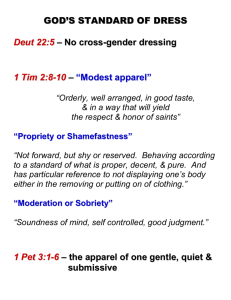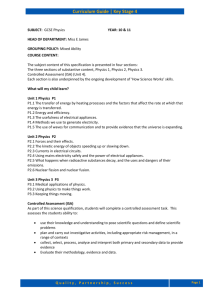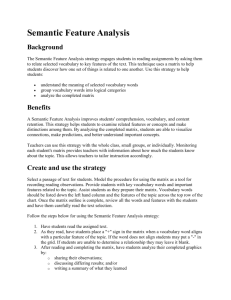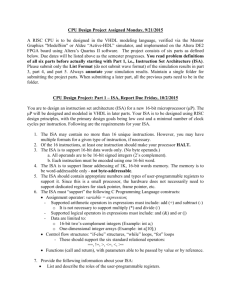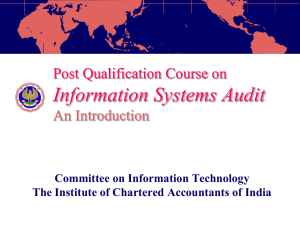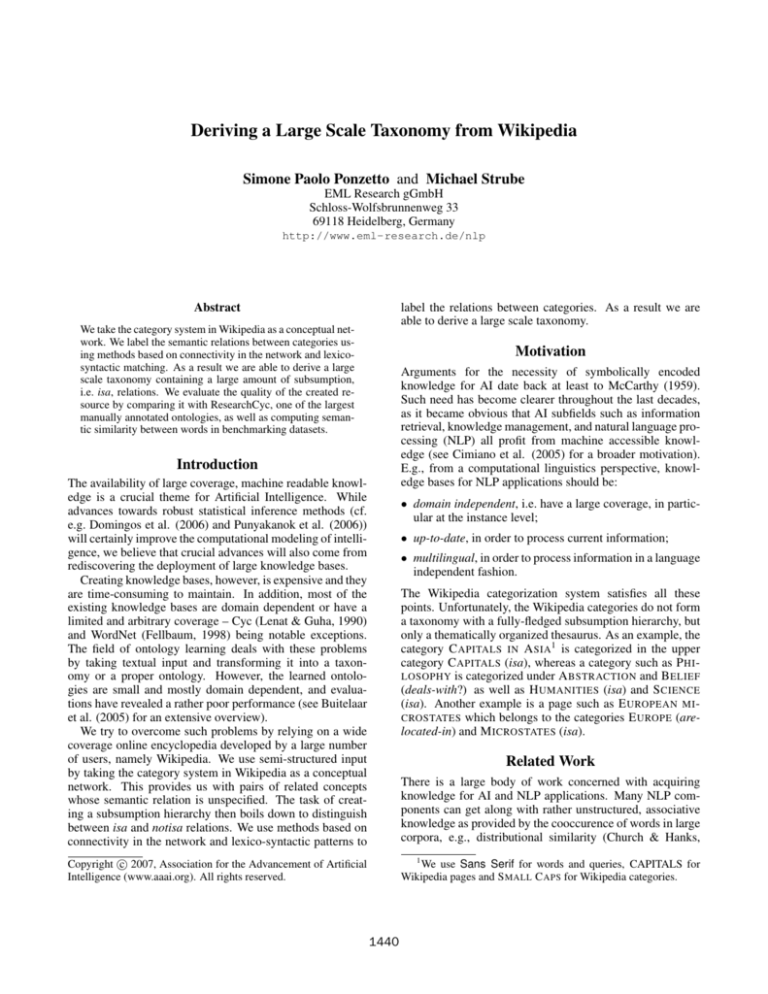
Deriving a Large Scale Taxonomy from Wikipedia
Simone Paolo Ponzetto and Michael Strube
EML Research gGmbH
Schloss-Wolfsbrunnenweg 33
69118 Heidelberg, Germany
http://www.eml-research.de/nlp
label the relations between categories. As a result we are
able to derive a large scale taxonomy.
Abstract
We take the category system in Wikipedia as a conceptual network. We label the semantic relations between categories using methods based on connectivity in the network and lexicosyntactic matching. As a result we are able to derive a large
scale taxonomy containing a large amount of subsumption,
i.e. isa, relations. We evaluate the quality of the created resource by comparing it with ResearchCyc, one of the largest
manually annotated ontologies, as well as computing semantic similarity between words in benchmarking datasets.
Motivation
Arguments for the necessity of symbolically encoded
knowledge for AI date back at least to McCarthy (1959).
Such need has become clearer throughout the last decades,
as it became obvious that AI subfields such as information
retrieval, knowledge management, and natural language processing (NLP) all profit from machine accessible knowledge (see Cimiano et al. (2005) for a broader motivation).
E.g., from a computational linguistics perspective, knowledge bases for NLP applications should be:
Introduction
The availability of large coverage, machine readable knowledge is a crucial theme for Artificial Intelligence. While
advances towards robust statistical inference methods (cf.
e.g. Domingos et al. (2006) and Punyakanok et al. (2006))
will certainly improve the computational modeling of intelligence, we believe that crucial advances will also come from
rediscovering the deployment of large knowledge bases.
Creating knowledge bases, however, is expensive and they
are time-consuming to maintain. In addition, most of the
existing knowledge bases are domain dependent or have a
limited and arbitrary coverage – Cyc (Lenat & Guha, 1990)
and WordNet (Fellbaum, 1998) being notable exceptions.
The field of ontology learning deals with these problems
by taking textual input and transforming it into a taxonomy or a proper ontology. However, the learned ontologies are small and mostly domain dependent, and evaluations have revealed a rather poor performance (see Buitelaar
et al. (2005) for an extensive overview).
We try to overcome such problems by relying on a wide
coverage online encyclopedia developed by a large number
of users, namely Wikipedia. We use semi-structured input
by taking the category system in Wikipedia as a conceptual
network. This provides us with pairs of related concepts
whose semantic relation is unspecified. The task of creating a subsumption hierarchy then boils down to distinguish
between isa and notisa relations. We use methods based on
connectivity in the network and lexico-syntactic patterns to
The Wikipedia categorization system satisfies all these
points. Unfortunately, the Wikipedia categories do not form
a taxonomy with a fully-fledged subsumption hierarchy, but
only a thematically organized thesaurus. As an example, the
category C APITALS IN A SIA1 is categorized in the upper
category C APITALS (isa), whereas a category such as P HI LOSOPHY is categorized under A BSTRACTION and B ELIEF
(deals-with?) as well as H UMANITIES (isa) and S CIENCE
(isa). Another example is a page such as E UROPEAN MI CROSTATES which belongs to the categories E UROPE (arelocated-in) and M ICROSTATES (isa).
c 2007, Association for the Advancement of Artificial
Copyright Intelligence (www.aaai.org). All rights reserved.
1
We use Sans Serif for words and queries, CAPITALS for
Wikipedia pages and S MALL C APS for Wikipedia categories.
• domain independent, i.e. have a large coverage, in particular at the instance level;
• up-to-date, in order to process current information;
• multilingual, in order to process information in a language
independent fashion.
Related Work
There is a large body of work concerned with acquiring
knowledge for AI and NLP applications. Many NLP components can get along with rather unstructured, associative
knowledge as provided by the cooccurence of words in large
corpora, e.g., distributional similarity (Church & Hanks,
1440
Category network cleanup (1)
1990; Lee, 1999; Weeds & Weir, 2005, inter alia) and vector space models (Schütze, 1998). Such unlabeled relations
between words proved to be as useful for disambiguating
syntactic and semantic analyses as the manually assembled
knowledge provided by WordNet.
However, the availability of reliable preprocessing components like POS taggers, syntactic and semantic parsers
allows the field to move towards higher level tasks, such
as question answering, textual entailment, or complete dialogue systems which require to understand language. This
lets researchers focus (again) on taxonomic and ontological
resources. The manually constructed Cyc ontology provides
a large amount of domain independent knowledge. However, Cyc cannot (and is not intended to) cope with most specific domains and current events. The emerging field of ontology learning tries to overcome these problems by learning
(mostly) domain dependent ontologies from scratch. However, the generated ontologies are relatively small and the
results rather poor (e.g., Cimiano et al. (2005) report an Fmeasure of about 33% with regard to an existing ontology
of less than 300 concepts). It seems to be more promising
to extend existing resources such as Cyc (Matuszek et al.,
2005) or WordNet (Snow et al., 2006). The examples shown
in these works, however, seem to indicate that the extension takes place mainly with respect to named entities, a
task which is arguably not as difficult as creating a complete
(domain-) ontology from scratch.
Another approach for building large knowledge bases relies on input by volunteers, i.e., on collaboration among the
users of an ontology (Richardson & Domingos, 2003). However, the current status of the Open Mind and MindPixel
projects2 does indicate that they are largely academic enterprises. Similar to the Semantic Web (Berners-Lee et al.,
2001), where users are supposed to explicitly define the semantics of the contents of web pages, they may be hindered by too high an entrance barrier. In contrast, Wikipedia
and its categorization system feature a low entrance barrier
achieving quality by collaboration. In Strube & Ponzetto
(2006) we proposed to take the Wikipedia categorization
system as a semantic network which served as basis for computing the semantic relatedness of words. In the present
work we develop this idea a step further by automatically
assigning isa and notisa labels to relations between the categories. That way we are able to compute the semantic similarity between words instead of their relatedness.
We start with the full categorization network consisting of
165,744 category nodes with 349,263 direct links between
them. We first clean the network from meta-categories
used for encyclopedia management, e.g. the categories under W IKIPEDIA ADMINISTRATION. Since this category is
connected to many content bearing categories, we cannot
remove this portion of the graph entirely. We remove instead all those nodes whose labels contain any of the following strings: wikipedia, wikiprojects, lists, mediawiki,
template, user, portal, categories, articles, pages. This
leaves 127,325 categories and 267,707 links still to be processed.
Refinement link identification (2)
The next preprocessing step includes identifying so-called
refinement links. Wikipedia users tend to organize many
category pairs using patterns such as Y X and X BY Z (e.g.
M ILES DAVIS ALBUMS and A LBUMS BY ARTIST). We label these patterns as expressing is-refined-by semantic relations between categories. While these links could be in
principle assigned a full isa semantics, they represent metacategorization relations, i.e., their sole purpose is to better
structure and simplify the categorization network. We take
all categories containing by in the name and label all links
with their subcategories with an is-refined-by relation. This
labels 54,504 category links and leaves 213,203 relations to
be analyzed.
Syntax-based methods (3)
The first set of processing methods to label relations between
categories as isa is based on string matching of syntactic
components of the category labels.
Head matching. The first method labels pairs of categories sharing the same lexical head, e.g. B RITISH COM PUTER SCIENTISTS isa C OMPUTER SCIENTISTS . We parse
the category labels using the Stanford parser (Klein & Manning, 2003). Since we parse mostly NP fragments, we constrain the output of the head finding algorithm (Collins,
1999) to return a lexical head labeled as either a noun or
a 3rd person singular present verb (this is to tolerate errors
where plural noun heads have been wrongly identified as
verbs). In addition, we modify the head finding rules to return both nouns for NP coordinations (e.g. both buildings
and infrastructures for B UILDINGS AND INFRASTRUC TURES IN JAPAN ). Finally, we label a category link as isa if
the two categories share the same head lemma, as given by
a finite-state morphological analyzer (Minnen et al., 2001).
Methods
Since May 2004 Wikipedia allows for structured access by
means of categories3 . The categories form a graph which
can be taken to represent a conceptual network with unspecified semantic relations (Strube & Ponzetto, 2006). We
present here our methods to derive isa and notisa relations
from these generic links.
Modifier matching. We next label category pairs as notisa in case the stem of the lexical head of one of the categories, as given by the Porter stemmer (Porter, 1980), occurs
in non-head position in the other category. This is to rule out
thematic categorization links such as CRIME COMICS and
CRIME or ISLAMIC MYSTICISM and ISLAM .
2
www.openmind.org and www.mindpixel.com
Wikipedia can be downloaded at http://download.
wikimedia.org. In our experiments we use the English
Wikipedia database dump from 25 September 2006. This includes
1,403,207 articles, 99% of which are categorized.
3
Both methods achieve a good coverage by identifying respectively 72,663 isa relations by head matching and 37,999
notisa relations by modifier matching.
1441
1. NP2,? (such as|like|, especially) NP* NP1
a stimulant such as caffeine
1. NP2’s NP1
car’s engine
2. such NP2 as NP* NP1
such stimulants as caffeine
2. NP1 in NP2
engine in the car
3. NP1 NP* (and|or|,like) other NP2
caffeine and other stimulants
3. NP2 with NP1
a car with an engine
4. NP1, one of det pl NP2
caffeine, one of the stimulants
4. NP2 contain(s|ed|ing) NP1
a car containing an engine
5. NP1, det sg NP2 rel pron
caffeine, a stimulant which
5. NP1 of NP2
the engine of the car
6. NP2 like NP* NP1
stimulants like caffeine
6. NP1 are? used in NP2
engines used in cars
7. NP2 ha(s|ve|d) NP1
a car has an engine
Figure 1: Patterns for isa and notisa Detection
Connectivity-based methods (4)
in cases where relations are unlikely to be found in free text.
Using instance categorization and redundant categorization
we find 9,890 and 11,087 isa relations, respectively.
The next set of methods employed relies on the structure and
connectivity of the categorization network.
Instance categorization. Suchanek et al. (2007) show
that instance-of relations in Wikipedia between entities (denoted by pages) and classes (denoted by categories) can
be found heuristically with high accuracy by determining
whether the head of the page category is plural, e.g. ALBERT EINSTEIN belongs to the NATURALIZED CITIZENS
OF THE U NITED S TATES category. We apply this idea to isa
relation identification as follows. For each category c,
Lexico-syntactic based methods (5)
After applying methods (1-4) we are left with 81,564 unclassified relations. We next apply lexico-syntactic patterns
to sentences in large text corpora to identify isa relations
(Hearst, 1992; Caraballo, 1999). In order to reduce the
amount of unclassified relations and to increase the precision of the isa patterns we also apply patterns to identify
notisa relations. We assume that patterns used for identifying meronymic relations (Berland & Charniak, 1999;
Girju et al., 2006) indicate that the relation is not an isa relation. The text corpora used for this step are the English
Wikipedia (5 × 108 words) and the Tipster corpus (2.5 × 108
words; Harman & Liberman (1993)). In the patterns for detecting isa and notisa relations (Figure 1) NP1 represents the
hyponym, NP2 the hypernym, i.e., we want to retrieve NP1
isa NP2; NP* represents zero or more coordinated NPs.
To improve the recall of applying these patterns, we use
only the lexical head of the categories which were not identified as named entities. That is, if the lexical head of a category is identified by a Named Entity Recognizer (Finkel
et al., 2005) as belonging to a named entity, e.g. Brands in
Y UM ! B RANDS, we use the full category name, else we simply use the head, e.g. albums in M ILES DAVIS ALBUMS.
In order to ensure precision in applying the patterns, both
the Wikipedia and Tipster corpora were preprocessed by a
pipeline consisting of a trigram-based statistical POS tagger
(Brants, 2000) and a SVM-based chunker (Kudoh & Matsumoto, 2000), to identify noun phrases (NPs).
The patterns are used to provide evidence for semantic relations employing a majority voting strategy. We positively
label a category pair with isa in case the number of matches
of positive patterns is greater than the number of matches
of negative ones. In addition, we use the patterns to filter
the isa relations created by the connectivity-based methods
(4). This is due to instance categorization and redundant
categorization giving results which are not always reliable,
1. we find the page titled as the category or its lemma,
for instance the page MICROSOFT for the category M I CROSOFT;
2. we then collect all the page’s categories whose lexical
head is a plural noun CP = {c1 , c2 , . . . cn };
3. for each c’s supercategory sc, we label the relation between c and sc as isa, if the head lemma of sc matches
the head lemma of at least one category cp ∈ CP .
For instance, from the page MICROSOFT being categorized
into C OMPANIES LISTED ON NASDAQ, we collect evidence that Microsoft is a company and accordingly categorize as isa the links between M ICROSOFT and C OMPUTER
AND VIDEO GAME COMPANIES . The idea is to collect evidence from the instance describing the concept and propagate such evidence to the described concept itself.
Redundant categorization. This method labels pairs of
categories which have at least one page in common. If users
redundantly categorize by assigning two directly connected
categories to a page, they often mark by implicature the page
as being an instance of two different category concepts with
different granularities, e.g. ETHYL CARBAMATE is both
an A MIDE ( S ) and an O RGANIC COMPOUND ( S ). Assuming
that the page is an instance of both conceptual categories, we
can conclude by transitivity that one category is subsumed
by the other, i.e. A MIDES isa O RGANIC COMPOUNDS.
The connectivity-based methods provide positive isa links
1442
e.g. we incorrectly find that C ONSONANTS isa P HONETICS.
We use the same majority voting scheme, except that this
time we mark as notisa those pairs with a number of negative matches greater than the number of positive ones. This
ensures better precision by leaving the recall basically unchanged. These methods create 15,055 isa relations and filter out 3,277 previously identified positive links.
baseline (methods 1-3)
+ connectivity (methods 1-4, 6)
+ pattern-based (methods 1-3, 5-6)
all (methods 1-6)
R
73.7
80.6
84.3
89.1
P
100.0
91.8
91.5
86.6
F1
84.9
85.8
87.7
87.9
Table 1: Comparison with Cyc
Inference-based methods (6)
differences in performance are statistically significant at p <
0.001. We test for statistical significance by performing a
McNemar test.
The last set of methods propagate the previously found relations by means of multiple inheritance and transitivity. We
first propagate all isa relations to those superclasses whose
head lemma matches the head lemma of a previously identified isa superclass. E.g., once we found that M ICROSOFT
isa C OMPANIES LISTED IN NASDAQ we can infer also that
M ICROSOFT isa M ULTINATIONAL COMPANIES.
We then propagate all isa links to those superclasses
which are connected through a path found along the previously discovered subsumption hierarchy. E.g., given that
F RUIT isa C ROPS and C ROPS isa E DIBLE PLANTS, we can
infer that F RUITS isa E DIBLE PLANTS.
Discussion and Error Analysis. The simple methods employed for the baseline work suprisingly good with perfect
precision and somewhat satisfying recall. However, since
only categories with identical heads are connected, we do
not create a single interconnected taxonomy but many separate taxonomic islands. In practice we simply find that H IS TORICAL BUILDINGS are B UILDINGS . The extracted information is trivial.
By applying the connectivity-based methods we are able
to improve the recall considerably. The drawback is a decrease in precision. However, a closer look reveals that
we now in fact created a interconnected taxonomy where
concepts with quite different linguistic realization are connected. We observe the same trend by applying the patternbased methods in addition to the baseline. They improve the
recall even more, but they also have a lower precision. The
best results are obtained by combining all methods.
Because we did not expect such a big drop in precision
– and only moderate improvement over the baseline in Fmeasure – we closely inspected a random sample of 200
false positives, i.e., the cases which led to the low precision score. Three annotators labeled these cases as true if
judged to be in fact correct isa relations, false otherwise.
It turned out that about 50% of the false positives were indeed labeled correctly as isa relations by the system, but
these relations could not be found in Cyc. This is due to
(1) Cyc missing the required relations (e.g. B RIAN E NO isa
M USICIANS) or (2) missing the required concepts (e.g., we
correctly find that B EE T RAIN isa A NIMATION S TUDIOS,
but since Cyc provides only the T RAIN -T RANSPORTATION D EVICE and S TUDIO concepts, we query: “is train a studio?” which leads to a false positive.
Evaluation
We evaluate the coverage and quality of the semantic relations extracted automatically. This is because the size of the
induced taxonomy is very large – up to 105,418 generated
isa semantic links – and also to avoid any bias in the evaluation method.
Comparison with ResearchCyc
We first compute the amount of isa relations we correctly
extracted by comparing with ResearchCyc4 , the research
version of the Cyc knowledge base (Lenat & Guha, 1990)
including (as of version 1.0) more than 300,000 concepts
and 3 millions assertions. For each category pair, we first
map each category to its Cyc concept using Cyc’s internal
lexeme-to-concept denotational mapper. Concepts are found
by querying the full category label (e.g. Alan Turing). In
case no matching concept is found, we fall back to querying
its lexical head (hardware for IBM hardware).
We evaluate only the 85% of the pairs which have corresponding concepts in Cyc. These pairs are evaluated by
querying Cyc whether the concept denoted by the Wikipedia
subcategory is either an instance of (#$isa) or is generalized by (#$genls) the concept denoted by its superclass5 .
We then take the result of the query as the actual (isa or notisa) semantic class for the category pair and use it to evaluate the system’s response. This way we are able to compute standard measures of precision, recall and balanced Fmeasure. Table 1 shows the results obtained by taking the
syntax-based methods (i.e. head matching) as baseline and
incrementally augmenting them with different sets of methods, namely our connectivity and pattern based methods. All
Computing semantic similarity using Wikipedia
In Strube & Ponzetto (2006) we proposed to use the
Wikipedia categorization as a conceptual network to compute the semantic relatedness of words. However, we could
not compute semantic similarity, because approaches to
measuring semantic similarity that rely on lexical resources
use paths based on isa relations only. These are only available in the present work.
We perform an extrinsic evaluation by computing semantic similarity on two commonly used datasets, namely Miller
& Charles’ (1991) list of 30 noun pairs (M&C) and the
65 word synonymity list from Rubenstein & Goodenough
(1965, R&G). We compare the results obtained by using
4
http://research.cyc.com/
Note that our definition of isa is similar to the one found
in WordNet prior to version 2.1. That is, we do not distinguish
hyponyms that are classes from hyponyms that are instances (cf.
Miller & Hristea (2006)).
5
1443
WordNet
Wikirelate!
Wikirelate!
isa-only
Wikirelate!
PageRank filter
Wikirelate!
isa + PageRank
all
all
non-missing
all
non-missing
all
non-missing
all
non-missing
pl
0.72
0.60
0.65
0.67
0.71
0.68
0.72
0.73
0.76
M&C
wup lch
0.77 0.82
0.53 0.58
0.61 0.65
0.65 0.67
0.70 0.72
0.74 0.73
0.79 0.78
0.79 0.78
0.84 0.82
res
0.78
0.30
0.41
0.69
0.74
0.62
0.68
0.81
0.86
pl
0.78
0.62
0.66
0.67
0.70
0.67
0.70
0.69
0.72
R&G
wup lch
0.82 0.86
0.63 0.64
0.69 0.70
0.69 0.70
0.73 0.73
0.74 0.73
0.79 0.77
0.75 0.74
0.79 0.77
res
0.81
0.34
0.42
0.66
0.70
0.58
0.63
0.76
0.80
Table 2: Results on correlation with human judgements of similarity measures
Wikipedia with the ones obtained by using WordNet, which
is the most widely used lexical taxonomy for this task. Following the literature on semantic similarity, we evaluate performance by taking the Pearson product-moment correlation
coefficient r between the similarity scores and the corresponding human judgements. For each dataset we report the
correlation computed on all pairs (all). In the case of word
pairs where at least one of the words could not be found the
similarity score is set to 0. In addition, we report the correlation score obtained by disregarding such pairs containing
missing words (non-missing).
Table 2 reports the scores obtained by computing semantic similarity in WordNet as well as in Wikipedia using different scenarios and measures (Rada et al. (1989, pl), Wu
& Palmer (1994, wup), Leacock & Chodorow (1998, lch),
Resnik (1995, res)). We first take as baseline the Wikirelate!
method outlined in Strube & Ponzetto (2006) and extend it
by first computing only paths based on isa relations. Since
experiments on development data6 revealed a performance
improvement far lower than expected, we performed an error
analysis. This revealed that many dissimilar pairs received a
score higher than expected, because of coarse-grained overconnected categories containing a large amount of dissimilar pages, e.g. mound and shore were directly connected
through L ANDFORMS though they are indeed quite different
according to human judges.
A way to model the categories’ connectivity is to compute
their authoritativeness, i.e. we assume that overconnected,
semantically coarse categories will be the most authoritative
ones. This can be accomplished for instance by computing the centrality scores of the Wikipedia categories. Since
the Wikipedia categorization network is a directed acyclic
graph, link analysis algorithms such as PageRank (Brin &
Page, 1998) can be easily applied to automatically detect and
remove these coarse categories from the categorization network. We take the graph given by all the categories and the
pages that point to them and apply the PageRank algorithm.
PageRank scores are computed recursively for each category
vertex v by the formula
P R(v) = (1 − d) + d
P R(v )
|O(v )|
v ∈I(v)
where d ∈ (0, 1) is a dumping factor (we set it to the standard value of .85), I(v) is the set of nodes linked to v and
|O(v )| the number of outgoing links of node v . This gives
a ranking of the most authoritative categories, which in our
case happen to be the categories in the highest regions of the
categorization network – i.e., the top-ranked categories are
F UNDAMENTAL, SOCIETY, KNOWLEDGE, PEOPLE, S CI ENCE, ACADEMIC DISCIPLINES and so on.
The third experimental setting of Table 2 shows the results obtained by computing relatedness using the method
from Strube & Ponzetto (2006) and removing the top 200
highest ranked PageRank categories7 . Finally, we present
results of using both isa and PageRank filtering. The results
indicate that using both isa relations and applying PageRank
filtering work better than the simple Wikirelate! baseline.
This is because in both cases we are able to filter out categories and category relations which decrease the similarity
scores, i.e. coarse-grained categories using PageRank, and
notisa (e.g. meronymic, antonymic) semantic relations. The
two methods are indeed complementary, which is shown by
the best results being obtained by applying them together.
Using PageRank filtering together with paths including only
isa relations yields results which are close to the ones obtained by using WordNet.
The results indicate that Wikipedia can be successfuly
used as a taxonomy to compute the semantic similarity of
words. In addition, our application of PageRank for filtering out coarse-grained categories highlights that, similarly
to the connectivity-based methods used to identify isa relations, the internal structure of Wikipedia can be used to
generate semantic content, being based on a meaningful set
of conventions the users tend to adhere.
Conclusions
We described the automatic creation of a large scale domain
independent taxonomy. We took Wikipedia’s categories as
6
In order to perform a blind test evaluation, we developed the
system for computing semantic similarity using a different version
of Wikipedia, namely the database dump from 19 February 2006.
7
The optimal threshold value was established again by analyzing performance on the development data.
1444
concepts in a semantic network and labeled the relations
between these concepts as isa and notisa relations by using methods based on the connectivity of the network and
on applying lexico-syntactic patterns to very large corpora.
Both connectivity-based methods and lexico-syntactic patterns ensure a high recall while decreasing the precision.
We compared the created taxonomy with ResearchCyc and
via semantic similarity measures with WordNet. Our Wikipedia-based taxonomy proved to be competitive with the two
arguably largest and best developed existing ontologies. We
believe that these results are caused by taking already structured and well-maintained knowledge as input.
Our work on deriving a taxonomy is the first step in creating a fully-fledged ontology based on Wikipedia. This will
require to label the generic notisa relations with particular
ones such as has-part, has-attribute, etc.
Hearst, M. A. (1992). Automatic acquisition of hyponyms from
large text corpora. In Proc. of COLING-92, pp. 539–545.
Klein, D. & C. D. Manning (2003). Fast exact inference with a factored model for natural language parsing. In S. Becker, S. Thrun,
& K. Obermayer (Eds.), Advances in Neural Information Processing Systems 15 (NIPS 2002), pp. 3–10. Cambridge, Mass.:
MIT Press.
Kudoh, T. & Y. Matsumoto (2000). Use of Support Vector Machines for chunk identification. In Proc. of CoNLL-00, pp. 142–
144.
Leacock, C. & M. Chodorow (1998). Combining local context and
WordNet similarity for word sense identification. In C. Fellbaum (Ed.), WordNet. An Electronic Lexical Database, Chp. 11,
pp. 265–283. Cambridge, Mass.: MIT Press.
Lee, L. (1999). Measures of distributional similarity. In Proc. of
ACL-99, pp. 25–31.
Lenat, D. B. & R. V. Guha (1990). Building Large KnowledgeBased Systems: Representation and Inference in the CYC
Project. Reading, Mass.: Addison-Wesley.
Matuszek, C., M. Witbrock, R. C. Kahlert, J. Cabral, D. Schneider,
P. Shah & D. Lenat (2005). Searching for common sense: Populating Cyc from the web. In Proc. of AAAI-05, pp. 1430–1435.
McCarthy, J. (1959). Programs with common sense. In Proceedings of the Teddington Conference on the Mechanization of
Thought Processes, pp. 75–91.
Miller, G. A. & W. G. Charles (1991). Contextual correlates of
semantic similarity. Language and Cognitive Processes, 6(1):1–
28.
Miller, G. A. & F. Hristea (2006). WordNet nouns: Classes and
instances. Computational Linguistics, 32(1):1–3.
Minnen, G., J. Carroll & D. Pearce (2001). Applied morphological processing of English. Natural Language Engineering,
7(3):207–223.
Porter, M. (1980). An algorithm for suffix stripping. Program,
14(3):130–137.
Punyakanok, V., D. Roth, W. Yih & D. Zimak (2006). Learning
and inference over constrained output. In Proc. of IJCAI-05, pp.
1117–1123.
Rada, R., H. Mili, E. Bicknell & M. Blettner (1989). Development
and application of a metric to semantic nets. IEEE Transactions
on Systems, Man and Cybernetics, 19(1):17–30.
Resnik, P. (1995). Using information content to evaluate semantic
similarity in a taxonomy. In Proc. of IJCAI-95, Vol. 1, pp. 448–
453.
Richardson, M. & P. Domingos (2003). Building large knowledge
bases by mass collaboration. In Proceedings of the 2nd International Conference on Knowledge Capture (K-CAP 2003). Sanibel Island, Fl., October 23–25, 2003, pp. 129–137.
Rubenstein, H. & J. Goodenough (1965). Contextual correlates of
synonymy. Communications of the ACM, 8(10):627–633.
Schütze, H. (1998). Automatic word sense discrimination. Computational Linguistics, 24(1):97–123.
Snow, R., D. Jurafsky & A. Y. Ng (2006). Semantic taxonomy
induction from heterogeneous evidence. In Proc. of COLINGACL-06, pp. 801–808.
Strube, M. & S. P. Ponzetto (2006). WikiRelate! Computing semantic relatedness using Wikipedia. In Proc. of AAAI-06, pp.
1419–1424.
Suchanek, F. M., G. Kasneci & G. Weikum (2007). YAGO: A core
of semantic knowledge. In Proc. of WWW-07.
Weeds, J. & D. Weir (2005). Co-occurrence retrieval: A flexible
framework for lexical distributional similarity. Computational
Linguistics, 31(4):439–475.
Wu, Z. & M. Palmer (1994). Verb semantics and lexical selection.
In Proc. of ACL-94, pp. 133–138.
Acknowledgements. This work has been funded by the
Klaus Tschira Foundation, Heidelberg, Germany. The first
author has been supported by a KTF grant (09.003.2004).
We thank our colleagues Katja Filippova and Christoph
Müller for useful feedback.
References
Berland, M. & E. Charniak (1999). Finding parts in very large
corpora. In Proc. of ACL-99, pp. 57–64.
Berners-Lee, T., J. Hendler & O. Lassila (2001). The semantic
web. Scientific American, 284(5):34–43.
Brants, T. (2000). TnT – A statistical Part-of-Speech tagger. In
Proc. of ANLP-00, pp. 224–231.
Brin, S. & L. Page (1998). The anatomy of a large-scale hypertextual web search engine. Computer Networks and ISDN Systems,
30(1–7):107–117.
Buitelaar, P., P. Cimiano & B. Magnini (Eds.) (2005). Ontology Learning from Text: Methods, Evaluation and Applications.
Amsterdam, The Netherlands: IOS Press.
Caraballo, S. A. (1999). Automatic construction of a hypernymlabeled noun hierarchy from text. In Proc. of ACL-99, pp. 120–
126.
Church, K. W. & P. Hanks (1990). Word association norms, mutual information, and lexicography. Computational Linguistics,
16(1):22–29.
Cimiano, P., A. Pivk, L. Schmidt-Thieme & S. Staab (2005).
Learning taxonomic relations from heterogenous sources of evidence. In P. Buitelaar, P. Cimiano & B. Magnini (Eds.), Ontology Learning from Text: Methods, Evaluation and Applications,
pp. 59–73. Amsterdam, The Netherlands: IOS Press.
Collins, M. (1999). Head-Driven Statistical Models for Natural
Language Parsing., (Ph.D. thesis). University of Pennsylvania.
Domingos, P., S. Kok, H. Poon, M. Richardson & P. Singla (2006).
Unifying logical and statistical AI. In Proc. of AAAI-06, pp. 2–7.
Fellbaum, C. (Ed.) (1998). WordNet: An Electronic Lexical
Database. Cambridge, Mass.: MIT Press.
Finkel, J. R., T. Grenager & C. Manning (2005). Incorporating nonlocal information into information extraction systems by Gibbs
sampling. In Proc. of ACL-05, pp. 363–370.
Girju, R., A. Badulescu & D. Moldovan (2006). Automatic
discovery of part-whole relations. Computational Linguistics,
32(1):83–135.
Harman, D. & M. Liberman (1993).
TIPSTER Complete.
LDC93T3A, Philadelphia, Penn.: Linguistic Data Consortium.
1445

